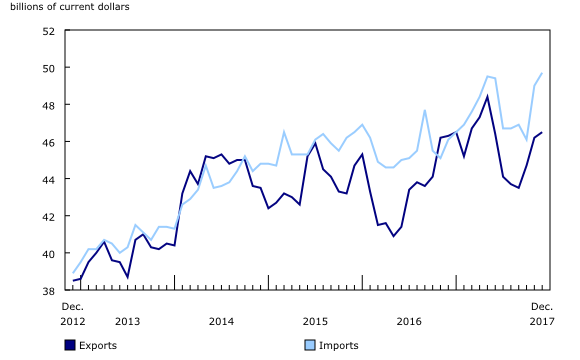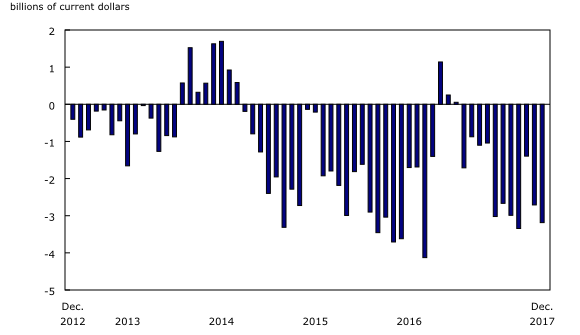Canadian international merchandise trade, December 2017
Archived Content
Information identified as archived is provided for reference, research or recordkeeping purposes. It is not subject to the Government of Canada Web Standards and has not been altered or updated since it was archived. Please "contact us" to request a format other than those available.
Released: 2018-02-06
Canada's merchandise trade deficit with the world totalled $3.2 billion in December, widening from a $2.7 billion deficit in November. Imports rose 1.5% and exports were up 0.6%, both led by energy products.
Widespread increases lead to record imports
Total imports were up 1.5% to a record $49.7 billion in December, with increases in 9 of 11 sections. Volumes rose 1.0% and prices increased 0.5%. Higher imports of energy products and industrial machinery, equipment and parts were partially offset by lower imports of aircraft and other transportation equipment and parts.
Imports of energy products were up 16.9% to $3.0 billion in December. Crude oil and crude bitumen imports increased 23.9%, while refined petroleum energy products rose 17.8%, mainly on higher imports of diesel and fuel oils. For the section as a whole, prices were up 8.8% and volumes increased 7.4%.
Imports of industrial machinery, equipment and parts also contributed to the overall gain in December, up 6.3% to $5.0 billion. Imports of logging, mining and construction machinery and equipment led the way, rising 24.6% to a record $897 million, the third consecutive monthly increase. These gains precede new emissions regulations affecting off-road diesel engines and machines. As of January 1, 2018, imports of equipment not meeting the new standards are no longer permitted.
Following two strong monthly increases, imports of aircraft and other transportation equipment and parts were down 23.4% in December to $1.7 billion, as fewer airliners were imported from the United States.
Exports rise for the third consecutive month
Total exports rose for the third consecutive month, up 0.6% to $46.5 billion in December despite decreases in 6 of 11 sections. Prices were up 0.5% while volumes were essentially unchanged. Higher exports of energy products, and metal and non-metallic mineral products were partially offset by lower exports of consumer goods. Exports excluding energy products decreased 0.6%.
Exports of energy products rose 6.2% to $8.5 billion in December, the fifth consecutive monthly increase and the highest level since November 2014. Following pipeline disruptions in November, exports of crude oil and crude bitumen led the increase in December, up 7.4% to $5.6 billion on higher volumes. Exports of natural gas (+26.6%) and electricity (+48.8%) also contributed to the gain as unusually low temperatures hit the North-eastern United States in December. For the section as a whole, prices were up 4.6% and volumes increased 1.5%.
Also contributing to the overall increase in December were higher exports of metal and non-metallic mineral products, up 7.7% to $5.6 billion. Unwrought precious metals and precious metal alloys led the increase on higher shipments of unwrought gold to Hong Kong, the United States and the United Kingdom.
Trade with non-US countries increases
Following a 5.6% increase in November, imports from countries other than the United States rose 6.8% to $18.2 billion in December, notably on higher imports of passenger cars and light trucks from Germany as well as refined petroleum energy products from the Netherlands.
Exports to countries other than the United States rose 4.9% to $11.6 billion in December, led by Japan (aircraft), India (potash), the United Kingdom (unwrought gold) and Hong Kong (also unwrought gold).
As a result, Canada's trade deficit with countries other than the United States widened from $6.0 billion in November to $6.6 billion in December.
Imports from the United States fell 1.3% to $31.5 billion in December, while exports to the United States were down 0.8% to $34.9 billion. Canada's trade surplus with the United States widened slightly from $3.3 billion in November to $3.4 billion in December.
Trade partially rebounds in the fourth quarter
Following a 7.6% decrease in the third quarter, nominal exports rose 4.6% to $137.4 billion in the fourth quarter, notably on higher exports of energy products. Imports increased 3.1% to $144.7 billion, mainly on higher imports of aircraft and other transportation equipment and parts as well as energy products. Consequently, Canada's quarterly merchandise trade deficit with the world narrowed from $9.0 billion in the third quarter to $7.3 billion in the fourth quarter.
In real (or volume) terms, quarterly imports rose 1.2% to $125.9 billion on higher imports of electronic and electrical equipment and parts. Following a 3.2% decline in the third quarter, real exports increased 0.3% to $121.2 billion in the fourth quarter, led by basic and industrial chemical, plastic and rubber products.
Nominal annual trade deficit narrows in 2017
Annual exports on a nominal basis were up 5.3% to $549.3 billion in 2017, almost entirely on higher energy product exports. Annual imports were up 4.7% to $573.2 billion. Imports of motor vehicles and parts, energy products, and consumer goods contributed the most to the increase. Consequently, Canada's annual merchandise trade deficit with the world narrowed from $25.9 billion in 2016 to $24.0 billion in 2017.
In real (or volume) terms, annual imports rose 4.2% to $496.2 billion, while annual real exports were up 1.2% to $489.5 billion.
Revisions to November exports and imports
Revisions reflected initial estimates being updated with or replaced by administrative and survey data as they became available, as well as amendments made for late documentation of high-value transactions. Exports in November, originally reported as $46.2 billion in last month's release, were essentially unchanged in the current month's release. November imports, originally reported as $48.7 billion in last month's release, were revised to $49.0 billion.
Note to readers
Merchandise trade is one component of Canada's international balance of payments (BOP), which also includes trade in services, investment income, current transfers and capital and financial flows.
International trade data by commodity are available on both a BOP and a customs basis. International trade data by country are available on a customs basis for all countries and on a BOP basis for Canada's 27 principal trading partners (PTPs). The list of PTPs is based on their annual share of total merchandise trade—imports and exports—with Canada in 2012. BOP data are derived from customs data by making adjustments for factors such as valuation, coverage, timing and residency. These adjustments are made to conform to the concepts and definitions of the Canadian System of National Accounts.
For a conceptual analysis of BOP versus customs-based data, see "Balance of Payments trade in goods at Statistics Canada: Expanding geographic detail to 27 principal trading partners."
For more information on these and other macroeconomic concepts, see the Methodological Guide: Canadian System of Macroeconomic Accounts (13-607-X) and User Guide: Canadian System of Macroeconomic Accounts (13-606-G).
Data in this release are on a BOP basis, seasonally adjusted and in current dollars. Constant dollars are calculated using the Laspeyres volume formula (2007=100).
For information on seasonal adjustment, see Seasonally adjusted data – Frequently asked questions.
Revisions
In general, merchandise trade data are revised on an ongoing basis for each month of the current year. Current-year revisions are reflected in both the customs and BOP-based data.
The previous year's customs data are revised with the release of the January and February reference months, and then on a quarterly basis. The previous two years of customs-based data are revised annually and revisions are released in February with the December reference month.
The previous year's BOP-based data are revised with the release of the January, February, March and April reference months. To remain consistent with the Canadian System of Macroeconomic Accounts, revisions to BOP-based data for previous years are released annually in December with the October reference month.
Factors influencing revisions include the late receipt of import and export documentation, incorrect information on customs forms, replacement of estimates produced for the energy section with actual figures, changes in classification of merchandise based on more current information, and changes to seasonal adjustment factors.
For information on data revisions for crude oil and natural gas, see "Revisions to trade data for crude oil and natural gas."
Revised data are available in the appropriate CANSIM tables.
Comparing Canadian and U.S. bilateral trade in goods data
A release entitled "Comparing Canadian and US bilateral trade in goods data," which outlines the primary factors responsible for differences between the published imports of one country and the published exports of the other, is published in The Daily today. As a way to help data users understand and monitor these differences, Statistics Canada will begin publishing bilateral trade in goods comparative tables for key trading partners, starting with the United States. These tables will be published on the Canada and the World Statistics Hub beginning March 2018 and will be updated on a quarterly basis.
Real-time CANSIM tables
Real-time CANSIM table 228-8059 will be updated on February 19. For more information, consult the document Real-time CANSIM tables.
Next release
Data on Canadian international merchandise trade for January will be released on March 7.
Products
Customs based data are now available in the Canadian International Merchandise Trade Database (65F0013X).
The updated Canada and the World Statistics Hub – United States (13-609-X) is now available from the home page of our website. This product illustrates the nature and the extent of Canada's economic and financial relationship with the United States using interactive graphs and tables. This product provides an easy access to information on trade, investment, employment and travel, including merchandise trade by Canadian provinces and US states.
Contact information
For more information, contact us (toll-free 1-800-263-1136; 514-283-8300; STATCAN.infostats-infostats.STATCAN@canada.ca).
To enquire about the concepts, methods or data quality of this release, contact Benoît Carrière at 613-415-5305 (benoit.carriere@canada.ca), International Accounts and Trade Division.
- Date modified:




